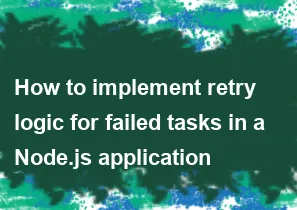How to implement retry logic for failed tasks in a Node.js application

Implementing retry logic for failed tasks in a Node.js application is a common requirement to enhance the robustness and resilience of your system. Here's a simple example using a basic retry mechanism:
javascriptconst MAX_RETRIES = 3;
const RETRY_DELAY = 1000; // 1 second
async function performTask() {
// Your task logic goes here
// For example, making an API call or performing an asynchronous operation
// Simulating a failure for demonstration purposes
throw new Error('Task failed');
}
async function retryFailedTask() {
let retries = 0;
while (retries < MAX_RETRIES) {
try {
// Attempt to perform the task
await performTask();
// If successful, break out of the loop
console.log('Task completed successfully');
break;
} catch (error) {
// Log the error (optional)
console.error(`Error during task execution: ${error.message}`);
// Increment the retry counter
retries++;
if (retries < MAX_RETRIES) {
// If retries are left, wait for a delay before retrying
console.log(`Retrying in ${RETRY_DELAY / 1000} seconds...`);
await new Promise(resolve => setTimeout(resolve, RETRY_DELAY));
} else {
// If maximum retries reached, log an error and exit the loop
console.error('Max retries reached. Task failed.');
break;
}
}
}
}
// Call the retry function
retryFailedTask();
In this example, performTask is a placeholder for the actual task you want to perform, and it throws an error to simulate a failure. The retryFailedTask function attempts to perform the task and retries up to MAX_RETRIES times with a delay of RETRY_DELAY milliseconds between each attempt.
You can customize the MAX_RETRIES and RETRY_DELAY values based on your specific requirements. Additionally, you may want to handle different types of errors differently, depending on your use case.
It's important to note that this is a basic example, and in a real-world scenario, you may need to consider more advanced strategies, such as exponential backoff, handling different types of errors, and implementing a circuit breaker pattern, depending on the nature of your application and tasks.
-
Popular Post
- How to optimize for Google's About This Result feature for local businesses
- How to implement multi-language support in an Express.js application
- How to handle and optimize for changes in mobile search behavior
- How to handle CORS in a Node.js application
- How to use Vue.js with a UI framework (e.g., Vuetify, Element UI)
- How to configure Laravel Telescope for monitoring and profiling API requests
- How to create a command-line tool using the Commander.js library in Node.js
- How to implement code splitting in a React.js application
- How to use the AWS SDK for Node.js to interact with various AWS services
- How to use the Node.js Stream API for efficient data processing
- How to implement a cookie parser middleware in Node.js
- How to implement WebSockets for real-time communication in React
-
Latest Post
- How to implement a dynamic form with dynamic field styling based on user input in Next.js
- How to create a custom hook for handling user interactions with the browser's device motion in Next.js
- How to create a custom hook for handling user interactions with the browser's battery status in Next.js
- How to implement a dynamic form with dynamic field visibility based on user input in Next.js
- How to implement a dynamic form with real-time collaboration features in Next.js
- How to create a custom hook for handling user interactions with the browser's media devices in Next.js
- How to use the useSWRInfinite hook for paginating data with a custom loading indicator in Next.js
- How to create a custom hook for handling user interactions with the browser's network status in Next.js
- How to create a custom hook for handling user interactions with the browser's location in Next.js
- How to implement a dynamic form with multi-language support in Next.js
- How to create a custom hook for handling user interactions with the browser's ambient light sensor in Next.js
- How to use the useHover hook for creating interactive image zoom effects in Next.js